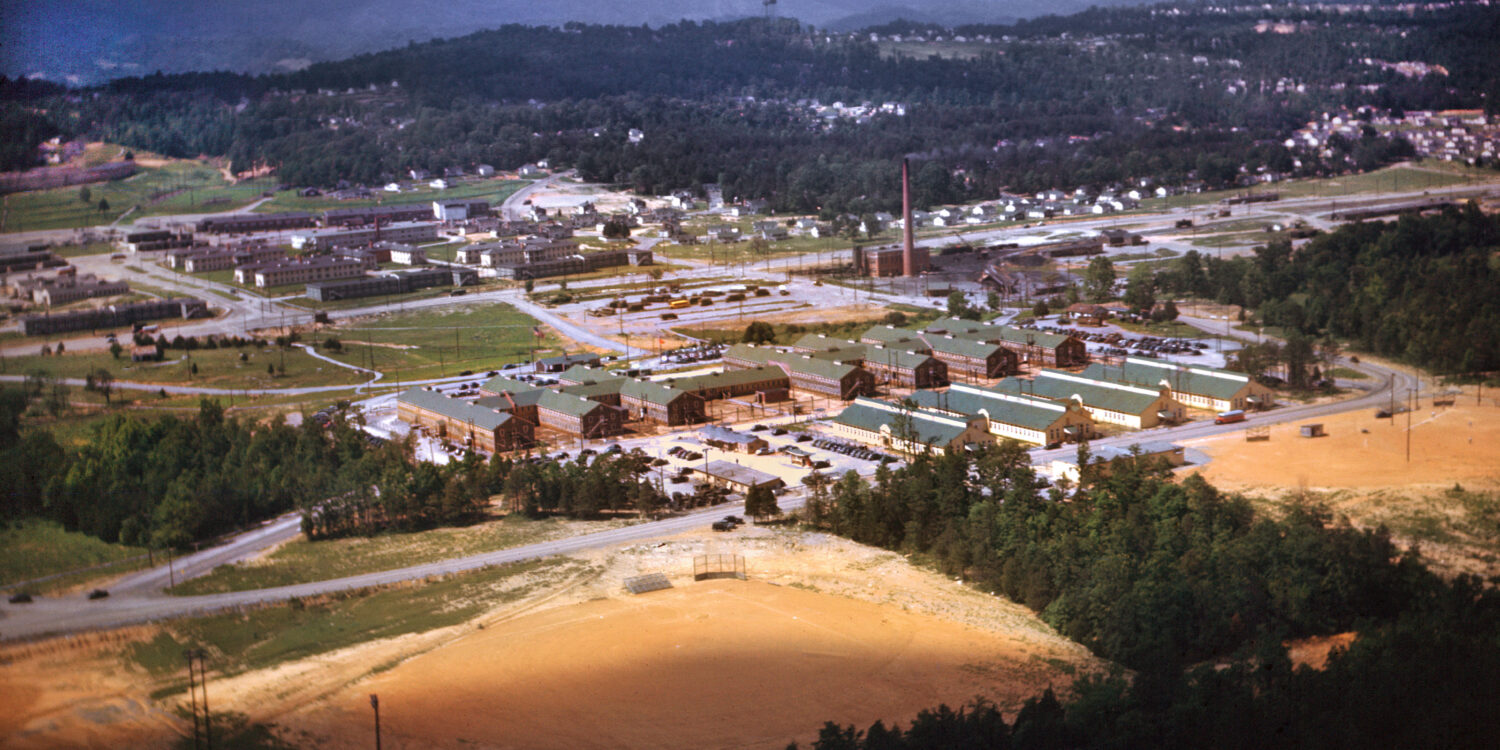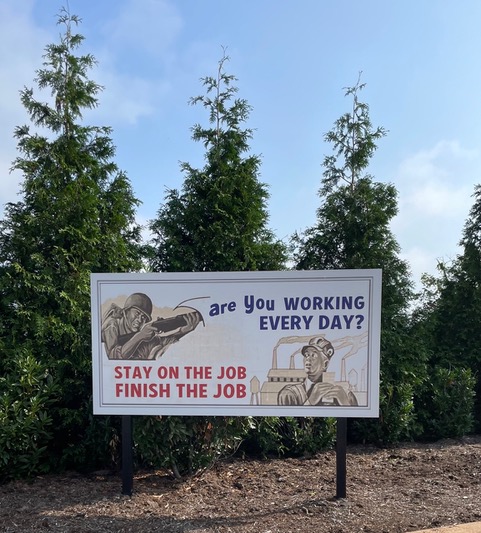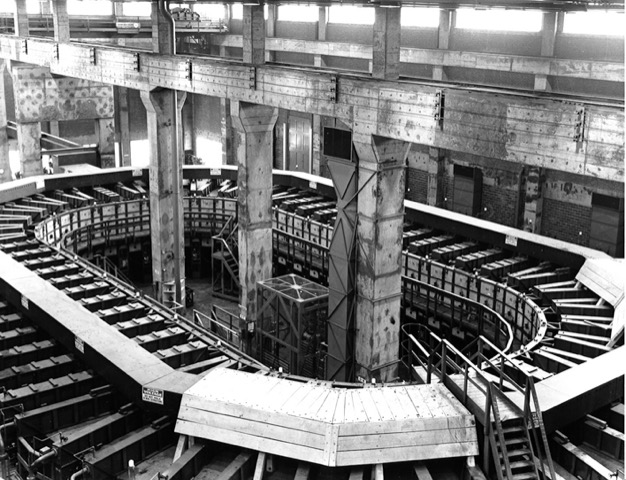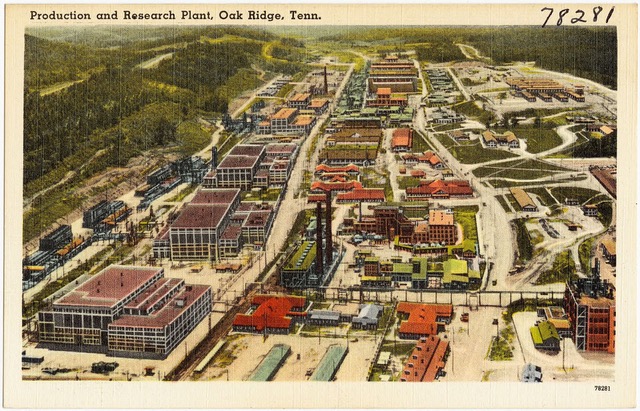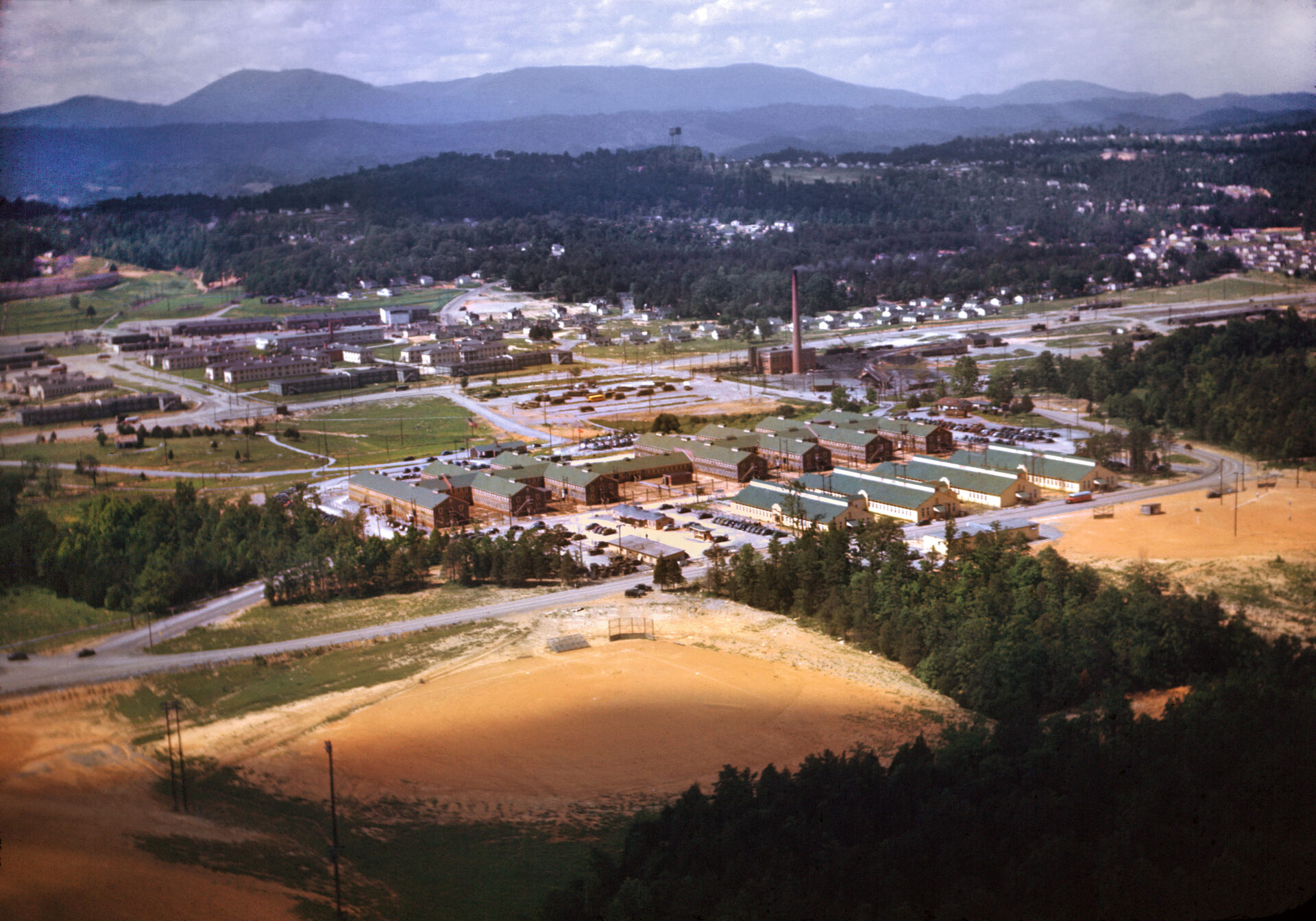To visit Oak Ridge, Tennessee is to ride a rollercoaster of greens and blues, dipping into the city’s four valleys and up again into its five ridgelines. It is to walk among its 600 acres of sprawling wetlands, to pass through rare cedar glades, to spy an osprey catching a fish. The landscape and the biodiversity of Oak Ridge is beautiful, plentiful, a vast resource at the foot of the Smokies.
The city of Oak Ridge is fairly young—born of war in 1942, the entire city was erected in two years and had a population of 66,000 by the summer of 1944. When Oak Ridge was chosen as a site for the Manhattan project, the government bought almost 60,000 acres of inhabited farmland in the Clinch River Valley for the planned city. Nuclear physicists and engineers quickly moved their families to the area. On the weekends, they could be found at the hastily constructed wood-framed bowling alley, movie theater or dance hall.
Now, the all-but-vacant mall houses the American Museum of Science and Energy in an old Sears building next to a yellowed JCPenney. The most lively the city gets is the daily gathering at Big Ed’s Pizza, a local 50-year-old institution beloved primarily for its nostalgia. Some of the alphabetically named streets still allude to the original Skidmore, Owings and Merrill-designed grid of churches, schools, restaurants, theaters, and residences. Oak Ridge was built around three nuclear facilities that filtered, tested, and shuttled nuclear materials between themselves like blood moving through organs: the campus of Oak Ridge National Laboratory, the sprawling gaseous diffusion plant K-25, and the Y-12 National Security Complex—what appears as a normal almost innocuous, brick encased factory. All three facilities researched and produced enriched uranium and other nuclear materials for the atomic bomb during the Manhattan Project. After the war, however, the war-time city and the nuclear facilities remained in the valley, administered by the Atomic Energy Commission and operated by defense contractor Union Carbide until 1984, and Martin Marietta (now Lockheed Martin) until 2000. The city of nuclear physicists, engineers, and scientists shifted to Cold War projects, producing uranium for experiments and weapons alike.
Oak Ridge, and indeed the entire atomic production, insists on boundaries and carefully compartmentalized tasks. This is why there were three separate sites for the production of differing materials: Oak Ridge, Los Alamos, New Mexico, and Hanford, Washington. The skin that separates the body of Oak Ridge from the rest of the world is the fence that once surrounded the entire city—a barbed wire, crudely-made fence, manned twenty-four-seven by the US Army. It is why the nuclear production facilities (X-10, K-25, and Y-12) operated completely independently from one another: workers during World War II were banned from speaking about their work across departments or at home. After the world war ended, the attitude of rigid boundaries remained: security clearances within facilities were—and still are—closely monitored and each person working within was given a badge on a necklace to measure radiation, a sort of boundary marker between body and danger.
My grandfather wore a radiation necklace to track exposure to work every day, clocked in, clocked out, and slowly the radiation leaked across the border of his body. When we say a person has “gone nuclear,” we mean an explosion—a sudden burst of anger—but I think differently now. Going nuclear means something slow, something sinister, something deep. Something burrowing into the fabric of your lungs, disguising itself until it’s too late. As Rob Nixon writes in Slow Violence, it’s a type of “violence that occurs gradually and out of sight, a violence of delayed destruction that is dispersed across time and space, an attritional violence that is typically not viewed as violence at all.” Nuclear—a mistake so slow you don’t even know it.
In Cold War Dixie, Kari Frederickson writes that “by 2007, more than seventy-two thousand workers, retirees, and family members of workers who staffed facilities at Savannah River, Hanford, Oak Ridge, the Nevada Test Site, the Rocky Flats Complex in Colorado, the Paducah Gaseous Diffusion Plant in Kentucky, and elsewhere had sought damages from the Energy Employees Occupational Illness Compensation Program to treat a range of cancers and other ills thought to be related to hazardous materials in their workplaces. Proving that a certain level of exposure created a particular illness is extremely difficult, and more than half of the claims have been denied.” My grandfather was one of the “lucky” ones to get approved practically instantly – his cancer is a spindle cell lung cancer – extremely rare and is very often caused by some type of radiation. The very existence of his cancer was all the proof we needed.
My grandfather worked in one of the three nuclear facilities in Oak Ridge, Y-12, in the 1970s. Post-war, Y-12 focused on new processes for lithium-6, releasing almost 700,000 pounds of mercury into the environment as a result. Since then, many grants and funds have been dedicated to environmental cleanups, ecological restoration and biological and climate-focused research. As Kate Brown writes in “Marie Curie’s Fingerprint,” from the end of World War II, “American propagandists, led by the atom-enthusiast William Laurence of the New York Times, denied the fact of radiation-related health effects in Japan and worked to rebrand the destructive “atom” into peaceful “nuclear” power that would generate the “white city” with clean, abundant energy. Promoting nuclear power’s benefits for science, medicine, and technology became the chief vehicle for purification of the image of the United States as a nation bent on reducing the globe to an irradiated ruin.” This is the distinct irony of these facilities – that while the remnants of contaminants, toxins, pollutants seep and collect within their frames, the researchers inside try, and fail, to undo this pollution.
By this time next year, more than likely my grandfather will be gone and so will most of Y-12’s original buildings, shut down permanently due to legacy contaminants. All buildings but two—the original 9731 building and the Beta 3 building—are slated for demolition. I cannot help but see the parallel to my grandfather’s own body—soon to be shut down due to its own legacy contaminants. The Department of Energy has decided that the buildings in Y-12 must come down—an acknowledgment that the dissolution of boundaries between the buildings, the environment, and radiation has become too much to bear. If this seems like a positive step forward, consider that the demolition is paving the way for a new Lithium Processing Plant – still focused on nuclear weapons.
In Max Liboiron’s Pollution is Colonialism, they define assimilative capacity as “the theory that environments can handle a specific amount of contaminant before harm occurs.” The threshold of harm occurs when the rate of pollution and the rate of metabolism are equal, meaning that before this threshold, a certain amount of pollution is permissible. Liboiron writes that, “Assimilation theory transforms bodies of water and other environments into a Resource for waste disposal.” It is not just environments that are transformed into a Resource for waste disposal, but bodies too.
The irony of Oak Ridge is that it is obsessed with boundaries, with barriers, with isolation, but radiation permeates across buildings, across people, rendering these borders obsolete. Even if everything goes “correctly” with nuclear production, it is still deadly. A certain amount of radiation, known as residual contamination, will always be present in these facilities, reactors, and testing sites. Some of the time this amount of radiation is deemed within the threshold of acceptable radiation, but in some cases—like the 380 facilities covered by the DOE’S Compensation Act—the radiation far exceeds the limit. Nuclear apocalypse does not just harm those it is aimed toward; it obliterates everything in its path—including the infrastructure that created it. If my grandfather’s radiation necklace had worked, if it had alerted him to a disaster, the Department of Energy would not have paid out within weeks of his diagnosis. But the necklace couldn’t work, because it was programmed for an accident, an influx of radiation all at once. It wasn’t set up for the slow, insidious seepage into his bones.
Oak Ridge leaks radiation not for any fault of planning, infrastructural disaster, or accident (though there have been accidents) but because of the assumption that it could ever have contained what it produced. The landscape, the economy, the military-industrial complex, families, lives, bodies, and my grandfather all are deeply entangled in the nuclear facility—and that includes radiation. How could it not?
Perhaps, it is time to acknowledge that some things—nuclear power, radiation—cannot be contained instead of promising better, more rigid boundaries. At its most literal, nuclear power created the city of Oak Ridge, but it is destroying it too. Oak Ridge could not exist without nuclearity, but it also cannot exist with it.
Oak Ridge is replicated and inscribed on the bodies of those who worked and lived there. When I see Oak Ridge, I don’t see just any body, I see my grandfather’s. I see his nuclear physicist brain, the way he taught me geometry when I was 14 because no one else could explain it in a way that made sense. I see myself walking with him every evening because “we need to stretch our legs.” And I see the cancer burrowing beneath the surface, the sarcoma nestled into his lungs. My grandfather lived in Oak Ridge, but Oak Ridge lives in him too.
